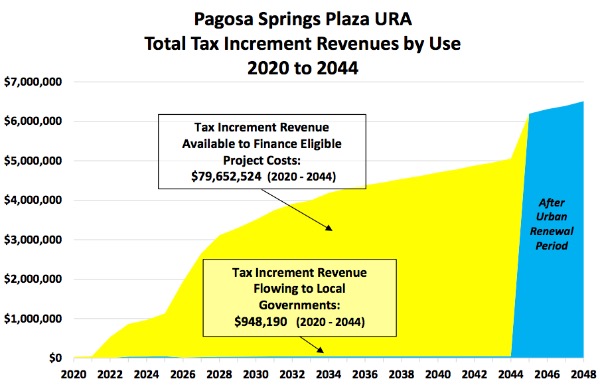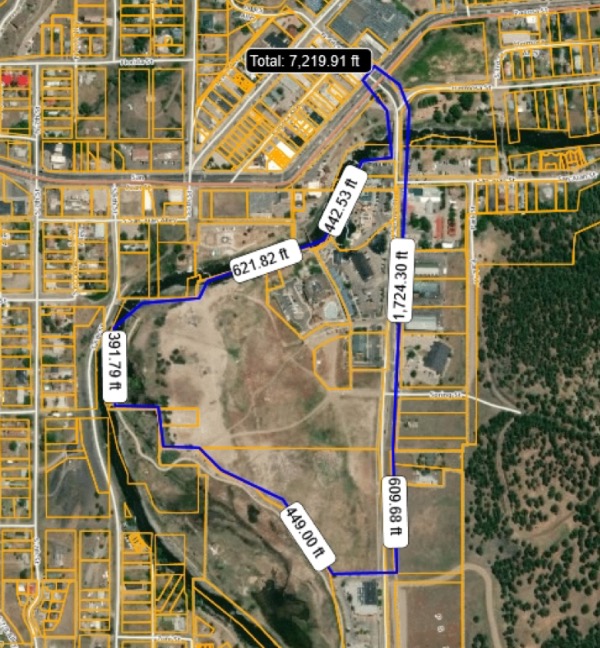Fake news and misinformation. It’s only one part of the problem.
Misinformation generally has to do with sharing facts, inaccurately. One of the most obvious tools of misinformation is the sharing an opinion, or a prediction, or an estimate, as if it were a “fact.” Another form of misinformation is to hide or ignore facts pertinent to the story; sharing only part of the truth, so to speak.
Yet another method of misleading the public is by mixing accurate data with inaccurate data — or with guesswork — to make the invalid data appear valid.

This chart shows, in yellow, the TIF revenue that our Town government might be able to funnel into the pockets of some particular property owners, to reimburse them for expanding a downtown resort and spa. The funds indicated by the yellow area are taxes that an expansion project would normally pay to help support the entire community, but when TIF funding is applied to a single expansion project, the community ‘donates’ the taxes back to the developer. The chart is not, however, displaying “facts”; the numbers shown are merely “wishful thinking” on behalf of the Springs Resort. But a colorful chart can easily make us feel that these numbers are, somehow, “real”.
We note, however, that this chart has not been shared extensively with the public, by the Springs Resort. Many other kinds of information have been shared rather freely, but not this particular chart.
Various forms of misinformation were used to considerable effect, back when Pagosa’s infamous fraud artist Fred Schmidt was president of the San Juan Water Conservancy District and was selling a massive tax-funded reservoir project to the people of Archuleta County — and especially, to the members of his own water conservancy board, and to the staff and board of the Pagosa Area Water and Sanitation District (PAWSD.)
The marketing of the Dry Gulch Reservoir involved the presentation of outrageous population projections as if they were unquestionable facts. I’ve shared previously the following rather ridiculous Powerpoint slide used by the Dry Gulch marketing team back in 2009, aimed at convincing us (and the board members of the two water districts) that Pagosa Springs would soon resemble Las Vegas, Nevada, and would have similar water needs.

The population “data” that went along with this marketing effort was equally outrageous.
During a decade-long marketing campaign, the community was told, over and over, that Dry Gulch would not cost the existing customers a penny. The project would be funded, we were told, by a new Water Resource Fee levied on “new construction.” The arriving newcomers, the people who were destined to make Pagosa Springs look like Las Vegas, would pay for the reservoir, because they were the ones creating the need for a 32,000 acre-foot water storage facility.
Growth would pay for Dry Gulch. Don’t worry.
By 2012, it had become completely obvious — even to the PAWSD board of directors — that “growth” was going to pay only a tiny portion of the proposed $357 million project. PAWSD cancelled their participation in the project and handed it off to a (basically incompetent) San Juan Water Conservancy District board. But PAWSD customers, with their increased water bills each month, are now paying off the loan PAWSD acquired to purchase Dry Gulch real estate.
It’s not always easily to discover what parts of a story are “misinformation” and which are factual.
But there’s another big problem that communities face, as they consider ways to build a strong, supportive economy… and the “Urban Renewal Authority” scheme recently proposed to the Town government by the Springs Resort is an excellent example of this problem.
The problem is our belief in exceptionalism.
As shown below, the owners of the Springs Resort have drawn a line around their own property and the adjacent vacant parcel, and want the Town Council to provide $79 million in tax subsidies over the next 25 years to allow them to expand their resort onto the vacant parcel.

None of the other 650 existing commercial properties spread throughout our community would receive tax subsidies. The subsidies would accrue only to the Springs Resort and their partners in the project, BWD Construction, to help finance the resort’s expansion plans.
If any of those other 650 commercial properties were to modernize or expand over the next 25 years, they would likely pay higher taxes. And yes, an expanded Springs Resort would also see their tax bill increase, but under the proposed TIF financing scheme, those higher taxes would go right back into the pockets of the Springs Resort owners, and BWD Construction, to help reimburse them for their expansion.
That is to say, an “Urban Renewal” project as proposed by the Springs Resort would define that one business as “exceptional” — as deserving of exceptional treatment.
The problem with exceptionalism is that the Springs Resort would not even be able to operate, unless it was surrounded by, and supported by, a community of 13,500 people and 650 businesses — a whole community of people and facilities who are spending their lives providing services, products, entertainment, medical care, fire protection, public education, home construction, water and sewer treatment, information, repairs, public safety… the list goes on.
We all depend on one another, in a functional small town.
About three years ago, a small group of Pagosa activists brought forward to the Town Council a plan for a Downtown Development Authority — a DDA — to be funded by Tax Increment Financing — TIF. The promoters of this plan had drawn up a map showing the downtown area that would benefit from the TIF money:

As we see, pretty much every business in downtown Pagosa would have been included in this TIF-funded plan. In particular, we note that the Springs Resort was included.
(The vacant 27-acre parcel adjacent to the Springs Resort, shown in pink, was not included. That was a mistake, in my humble opinion.)
Under this plan, all of the downtown businesses would have had a chance to vote on the creation of the new DDA entity. The DDA, if approved, could have developed TIF projects throughout the commercial downtown — not merely for the Springs Resort, but for everyone. If the downtown businesses believed that development of the vacant 27 acres adjacent to the resort were the most important project — to help create a vital downtown, for everyone — they could choose to underwrite the development of that area. But if the downtown businesses felt that the community as a whole had other, more pressing needs, they could apply the TIF funds to those needs.
When this proposal was brought before the Town Council in the summer of 2016, the Council voted four-to-two to reject the plan. Now, we’ve been told that the Town Council will hold a hearing on Tuesday, November 5, about a proposal to create a much more “exceptional” TIF scheme — one that will benefit, directly, only two business owners.
Promoting one particular development project as exceptional could certainly qualify as “misinformation” if you believe, as I do, that we are all in this thing together.
